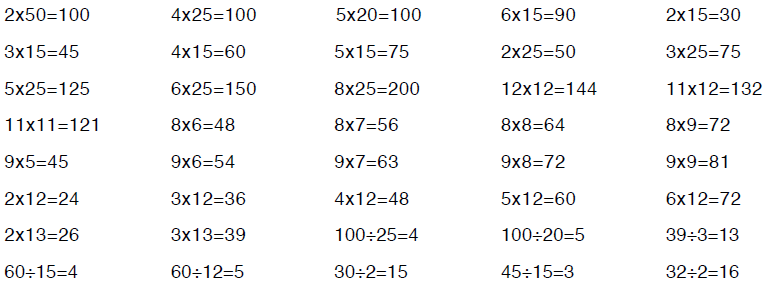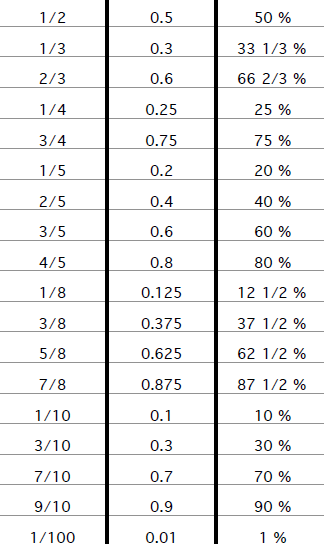Important Math Information
GRADE 6
Memorized items
multiplication facts (1 - 12)
Flashmania (see bottom of page)
whole place values to millions
decimal place values to thousandths
|
Measurement Equivalences 12 inches = 1 foot 3 feet = 1 yard 36 inches = 1 yard 5,280 feet = 1 mile 16 ounce = 1 pound 2,000 pounds = 1 ton 365 days = 1 year 52 weeks = 1 year 60 seconds = 1 minute 60 minutes = 1 hour |
Abbreviations in. for inch(es) ft. for foot or feet yd. for yard(s) mi. for mile(s) oz. for ounce(s) lb. for pound(s) yr. for year(s) sec. for second(s) min. for minute(s) hr. for hour(s) |
|
Vocabulary sum (+) difference (-) product (x) quotient (÷) even odd is greater than (>) is less than (<) |
example The sum of 3 and 8 is 11. The difference of 11 and 8 is 3. The product of 3 and 8 is 24. The quotient of 24 divided by 8 is 3. 18 is divisible by 2 so it is called an even number. 19 is not divisible by 2 so it is called an odd number. 19 is greater than 18 (19 >18). 19 is less than 20 (19<20). |
Skills
addition, subtraction, multiplication, and division of whole numbers
| 1, | 2 | 3 | 4, | 5 | 6 | 7 | . | 0 | 8 | 9 |
| millions | hundred-thousands | ten-thousands | thousands | hundreds | tens | ones | decimal point | tenths | hundredths | thousandths |
THE SUPER 40 FLASHAMANIA

GRADE 7 6th grade list plus:
Memorized items
prime numbers to 20 (2, 3, 5, 7, 11, 13, 17, 19)
powers of ten (101=10, 102 =100, 103=1000, 104= 10000, etc.)
| Vocabulary | example |
| factor | |
| The factors of 8 are 1, 2, 4, and 8. | |
| multiple | 8 is a multiple of 2. |
| numerator | In the fraction 4/5, 4 is the numerator. |
| denominator | In the fraction 4/5, 5 is the denominator. |
| prime number | 3 is a prime number because it has exactly two factors, 1 and 3. |
| composite number | 8 is a composite number because it has more than 2 factors. |
| proper fraction | 4/5 is a proper fraction because it is less than 1. |
| improper fraction | 5/4 is an improper fraction because it is more than 1. |
| mixed number | 1 1/4 is a mixed number. |
| divisible | 24 is divisible by 8 because it equals 3 with no remainder. |
|
compatible numbers |
240 and 80 are compatible numbers because they work well together. (240 ÷ 80 =3 |
| greatest common factor | The GCF of 8 and 20 is 4 because it is the largest number which is a |
| (GCF) | factor of both. |
| least common multiple | The LCM of 8 and 20 is 40 because it is the smallest number which is |
| (LCM) | a multiple of both. |
|
common denominator |
5/6 and 7/8 have a common denominator of 24. 5/6=20/24 and 7/8 = 21/24 |
| reciprocal | The reciprocal of 5 is 1/5 because 5 x 1/5 =1. |
| exponent | In 53, 3 is the exponent. |
| base | In 53, 5 is the base. |
| power | 53 can be read “5 to the power of 3”; 3 is the power. |
| squared number | 52 = 5 x 5 =25, thus 25 is a squared number. |
| cubed number | 53= 5 x 5 x 5 =125, thus 125 is a cubed number. |
| mean* | The mean is the average of a set of data. (*5.125) |
|
median* |
The median is the middle data value when the values are in sequential order.(*5.5) |
|
mode* |
The mode is the data value which occurs with the highest frequency.(*6) |
|
range* |
The range is the difference between the highest and the lowest values of a set of data.(*8) |
*Using the set of data: 1,3,4,5,6,6,7,9
|
meter liter gram perimeter area |
The basic unit of length in the metric system is the meter. The basic unit of capacity in the metric system is the liter. The basic unit of mass in the metric system is the gram. The perimeter is the distance around the outside of a polygon. Area is the measure, in square units, of an interior region. |
Skills
addition, subtraction, multiplication, and division of decimals
GRADE 8 6th and 7th grades plus:
Memorized items
fraction, decimal, percent equivalents (see bottom of next page)
|
order of operations |
( parentheses , exponents, multiplication and division in order as they appear, addition and subtraction in order as they appear) |
| Vocabulary | Example |
| commutative property | 18 + 72 = 72 + 18 and 2 x 12 x 5 = 2 x 5 x 12 |
| associative property | (25 + 40) + 60 = 25 + (40 + 60) and (5 x 20) x 14 = 5 x (20 x 14) |
| distributive property | 6 x 54 = 6 x (50 + 4)= (6 x 50) + (6 x 4) |
| percent (%) | A percent is a ratio which compares a value to 100. |
| whole number | 0, 1, 2, 3, ... are the set of whole numbers. |
| integer | ... -3, -2, -1, 0, 1, 2, 3, ... are the integers. |
| positive number | Numbers greater than zero are positive numbers. |
| negative numbers | Numbers less than zero are negative numbers. |
|
opposite |
Numbers which are the same distance from zero on a number line are called opposites.(ex.5 and -5) |
| expression | 14+3, a+21, 5n, x+ y are examples of expressions. |
| equation | 14 + 3 =17,5n = 40 are examples of equations. |
|
variable |
In the expression 5n, n is the variable. It stands in place of a number or numbers. |
| geometry terms | |
| acute angle |
an angle between 0 and 90 degrees.  |
| obtuse angle |
an angle between 90 and 180 degrees.  |
| right angle |
an angle which measures 90 degrees.
|
| acute triangle |
a triangle with 3 acute angles.  |
| obtuse triangle |
a triangle with 1 obtuse angle.  |
| right triangle | a triangle with 1 right angle. |
| scalene triangle |
a triangle with no congruent sides.  |
| isosceles triangle |
a triangle with 2 congruent sides.  |
| equilateral triangle |
a triangle with 3 congruent sides.  |
|
polygon |
a plane figure made of 3 or more line segments connected at their endpoints. |
| triangle | a 3 sided polygon |
| quadrilateral | a 4 sided polygon |
| pentagon | a 5 sided polygon |
| hexagon | a 6 sided polygon |
| octagon | an 8 sided polygon |
| nonagon | a 9 sided polygon |
| decagon | a 10 sided polygon |
| surface area | the total area of the faces and curved surfaces of a solid figure |
| volume | the number of cubic units it takes to fill a solid figure |
| trapezoid | a quadrilateral with one pair of parallel sides
 |
| parallelogram | a quadrilateral with opposite sides parallel
 |
|
rhombus |
a parallelogram with 4 congruent sides
|
| rectangle | a parallelogram with 4 right angles  |
| square | a parallelogram with 4 congruent sides and 4 right angles
 |
| circle | a set of points equidistant from a given point (center) |
|
radius |
the distance from the center point to a point on the circle . AC is a radius.  |
|
diameter |
AB is a diameter. It passes through the center point. |
| circumference | the distance around the outside of a circle. |
Skills
addition, subtraction, multiplication, and division of fractions and mixed
numbers
| FRACTION | DECIMAL | PERCENT |
 |
||
| Prev | Next |